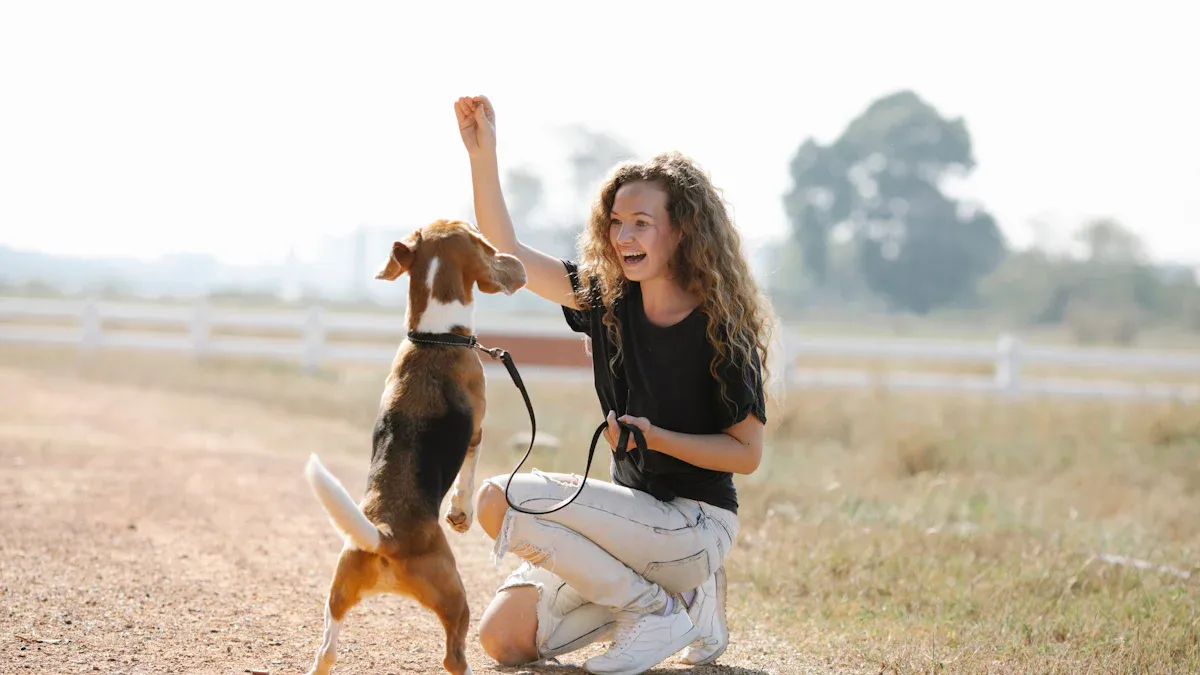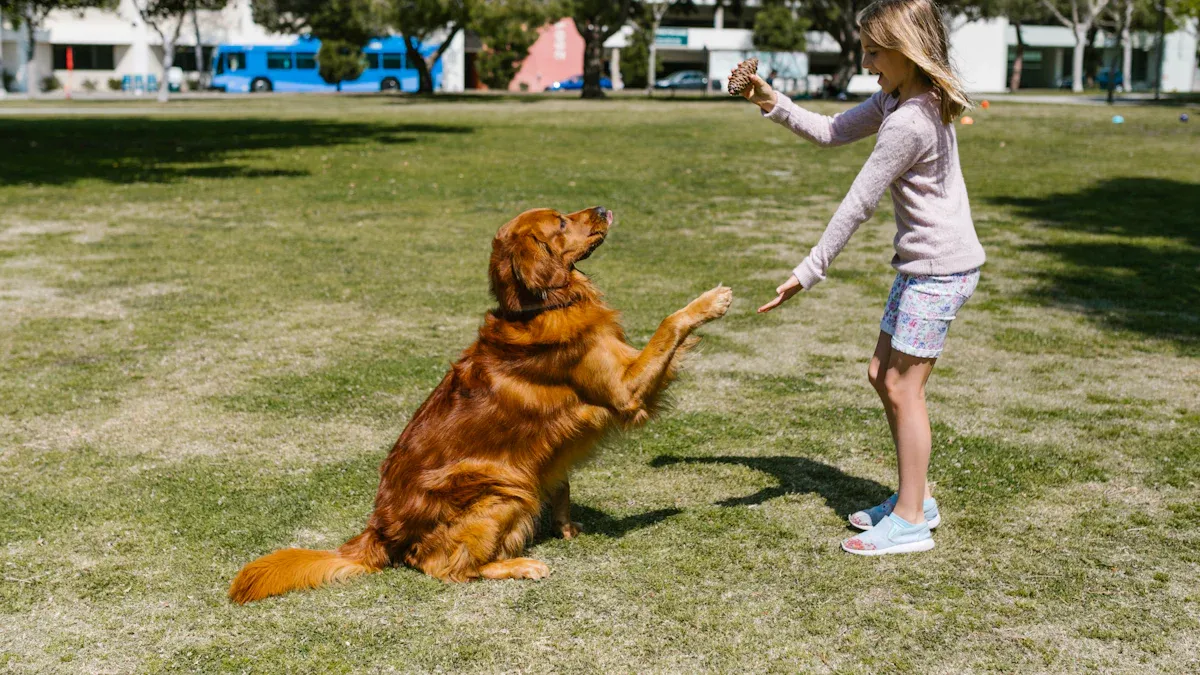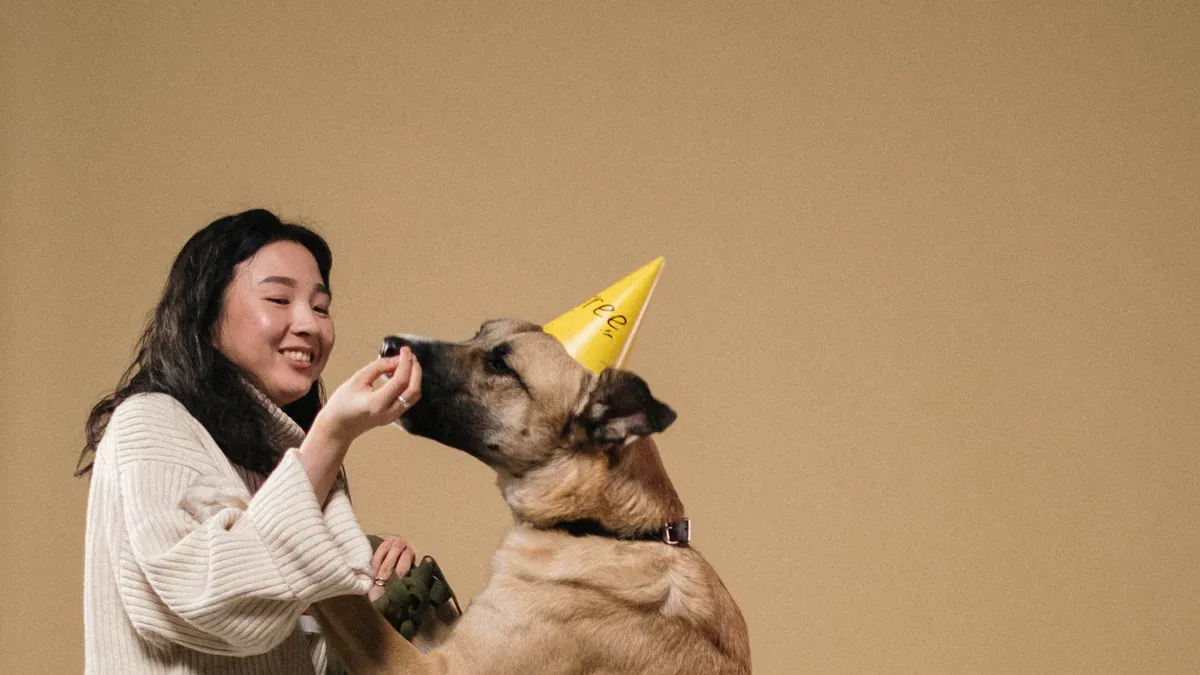
Taking care of your dog means more than just feeding or walking. It’s about creating a strong bond through love and effective dog care & training. Did you know almost all dogs—99.12%—experience behavior problems? Issues like fear, aggression, or anxiety often stem from inadequate care or training. Utilizing kind training methods helps your dog feel safe and happy. Simple tasks, such as brushing them or teaching commands, make a significant difference. When you prioritize dog care & training, you enhance their quality of life and build a stronger friendship with your dog.
Key Takeaways
Pick the right food for your dog’s age and needs. Good food keeps your dog healthy and full of energy.
Groom your dog often to keep them clean and healthy. It stops skin problems and helps you find health issues early.
Train your dog using rewards like treats and kind words. This helps them trust you and enjoy learning.
Let your dog meet others early to handle new things. This lowers fear and stress in strange places.
Add training to everyday tasks. Short lessons make learning easy and fun for your dog.
Essential Dog Care Tips

Feeding and Nutrition
Picking the right dog food
Choosing good food for your dog is very important. Dogs need a healthy diet to stay strong and active. Pick food that matches their age—puppy, adult, or senior. Puppies and nursing moms need more protein and fat. Older dogs do better with low-calorie food. Check labels for key nutrients like protein (at least 18% for adults) and fat (1%-2% for energy).
Nutrient Type | Minimum Requirement (Dry Matter) | Role in Canine Health |
|---|---|---|
Protein | Helps with growth, immunity, and overall health. | |
Fat | 1% to 2% for absorption | Gives energy and keeps skin healthy. |
Carbohydrates | N/A | Provides energy and aids digestion. |
Vitamins & Minerals | N/A | Needed for body functions and good health. |
Meal sizes and feeding times
Too much food can make dogs overweight, while too little can harm them. Feed your dog once or twice daily, based on their age and activity. Puppies need three meals a day, but adults are fine with one or two. Smaller meals help with digestion and prevent bloating. Adjust portions for your dog’s size, breed, and energy level.
Grooming and Hygiene
Brushing, bathing, and coat care
Grooming keeps your dog’s coat shiny and skin healthy. Brushing removes loose hair and dirt, stopping skin problems. Long-haired dogs need brushing to avoid tangles and mats. Bathing every few weeks cleans their coat and removes dirt. Use shampoos made for dogs to avoid skin issues. Grooming also helps you spot rashes, lumps, or parasites early.
Tip: Grooming spreads natural oils on your dog’s coat, keeping it healthy.
Nail trimming and ear cleaning
Long nails can hurt your dog and cause joint pain. Trim nails every 3-4 weeks or as needed. Use dog nail clippers and avoid cutting too close to the quick. Cleaning ears is also important. Dirt and wax can cause infections. Use vet-approved cleaners and a soft cloth to clean the outer ear gently.
Health and Wellness
Regular vet visits and check-ups
Taking your dog to the vet often is very important. Early care finds problems before they get worse, saving money later. Did you know 1 in 5 adult dogs and 2 in 5 senior dogs have issues found during check-ups? Regular visits keep your dog healthy. Many pet owners visit the vet twice a year to ensure their dog stays well.
Vaccinations and parasite control
Vaccines protect dogs from diseases like rabies and parvovirus. Core vaccines are needed for all dogs, while others depend on their lifestyle. Parasite prevention is also crucial. Fleas, ticks, and worms can make dogs very sick. Use vet-recommended treatments to keep your dog safe and healthy.
Note: Vaccines and parasite prevention are vital for your dog’s health.
Effective Dog Training Techniques

Positive Dog Training Methods
Using rewards like treats and praise
Reward-based training works wonders for teaching dogs. Giving treats, praise, or playtime encourages good behavior. For example, if your dog sits when asked, reward them with a treat or a happy “Well done!” This makes learning fun and strengthens your bond.
Studies show rewards improve learning by up to 80%. They work better than tools like shock collars. Dogs trained with rewards follow commands more easily and feel less stressed.
Evidence Description | Findings |
|---|---|
Rewards improve learning by up to 80%. | Helps dogs behave better and solve problems faster. |
Rewards are better than shock collars for training. | Dogs trained this way are calmer and respond better. |
Avoiding punishment-based techniques
Punishing dogs, like yelling or hitting, can hurt their trust. It may also cause fear or aggression. Instead, redirect bad behavior. For example, if your dog chews shoes, give them a chew toy instead. This teaches them what’s okay without scaring them.
Tip: Stay calm and patient while training. Dogs copy your mood.
Basic Dog Training Commands
Teaching “sit,” “stay,” and “come”
Start with easy commands like “sit,” “stay,” and “come.” These are the basics of good behavior. Use treats or toys to guide them. For example, hold a treat above their nose and move it back to make them sit. Reward them right away when they do it.
Clicker training is also helpful. A click sound paired with rewards helps dogs understand faster. Research shows these exercises improve both your dog’s skills and your connection with them.
Tips for consistency and patience
Being consistent is very important in training. Use the same words and actions for each command. Practice every day, but keep sessions short—5 to 10 minutes. Dogs, especially puppies, can’t focus for long. Be patient too. Every dog learns differently. Celebrate small wins and keep training positive.
Socialization and Behavior
Introducing your dog to new environments
Socializing early helps dogs handle new situations better. Take them to parks, stores, or car rides. Let them meet people and dogs in safe settings. This lowers the chance of fear or anxiety later.

Almost half of dogs show fear or anxiety, often from loud sounds or strange places. Early socialization helps them feel more confident and calm.
Managing fear and aggression
Knowing what scares your dog is important. If they act aggressive around strangers, reward calm behavior when someone new is near. Slowly expose them to triggers while giving treats or praise.
Note: Socializing early and using rewards help manage fear and aggression well.
Common Challenges in Dog Training
Barking Solutions
Finding out why dogs bark
Too much barking can be annoying, but figuring out why helps. Dogs bark for different reasons. Some bark because they’re bored, while others bark to warn you about something. Many dogs bark due to separation anxiety. Research shows 85.9% of dogs show behaviors like barking when left alone. Fear or worry also causes barking, especially with loud sounds, strangers, or new places.
Watch your dog closely to find the reason. Do they bark when you leave? Or is it when the doorbell rings? Knowing the cause helps you fix the problem.
Teaching dogs to bark less
After finding the reason, you can work on fixing it. If boredom causes barking, give your dog more exercise and fun activities. Walks, puzzle toys, or games can help. For barking from fear, try slowly introducing the scary thing. Reward them when they stay calm.
Tip: Be patient and reward quiet times to teach good habits.
Leash Training
Choosing the right leash and harness
Walking your dog should be fun, not a struggle. Using the right tools helps a lot. A strong leash and a harness that fits well give you better control. Don’t use retractable leashes, as they make pulling worse. A regular leash keeps your dog close and safe.
Teaching loose-leash walking
Loose-leash walking means your dog walks calmly beside you. Hold treats to guide them and reward them for staying close. If they pull, stop walking until they come back to you. This shows them pulling doesn’t work. Keep training short and focused for the best results.
Reactive Behavior
Knowing what upsets your dog
Reactive behavior, like barking or lunging, often comes from fear or excitement. Notice what bothers your dog. Is it other dogs, bikes, or loud sounds? Once you know, you can manage it. Stay far from the trigger and reward calm actions.
Helping dogs feel better around triggers
Desensitization helps dogs get used to things that upset them. Start by keeping the trigger far enough away so they feel safe. Slowly move closer over time. Use treats or praise when they stay calm. This teaches them to connect the trigger with good things.
Note: Fixing bad behavior takes time. Be consistent and celebrate small wins.
Quick Tips for Busy Pet Owners
Time-Saving Dog Care
Simplifying grooming routines
Grooming doesn’t have to take up your entire day. You can make it easier by creating a routine that works for both you and your dog. Start by easing your dog into the grooming space to help them feel comfortable. Use an all-in-one wash to save time during baths, and groom your dog after playtime when they’re calm and relaxed. Keep sessions short and take breaks if needed to avoid stress.
Tip: Play soothing music during grooming. It helps both you and your dog stay relaxed.
Regular grooming is essential for your dog’s hygiene. It removes loose hair and dirt, preventing skin issues. Don’t forget to include nail trims and ear cleaning in your routine. Using efficient tools like a slicker brush or nail grinder can save time while keeping your dog looking their best.
Preparing meals in advance
Meal prep isn’t just for humans—it works for dogs too! Preparing your dog’s meals in advance can save you time during busy mornings. Measure portions and store them in airtight containers. If you use fresh or homemade food, freeze individual servings to keep them fresh.
Note: Prepping meals ensures your dog gets the right portion sizes and nutrients every day.
Efficient Dog Training
Training during daily activities
You don’t need extra hours in your day to train your dog. Incorporate training into your daily routine. For example, practice commands like “sit” or “stay” while preparing their meals. Use walks as an opportunity to reinforce leash manners.
Tip: Turn everyday moments into training opportunities. It’s a great way to bond with your dog while teaching them new skills.
Short, focused training sessions
Dogs learn best in short bursts. Spend 5-10 minutes a day on focused training sessions. Pick one command or skill to work on at a time. This keeps your dog engaged and prevents frustration.
Consistency is key. Practice regularly, and don’t forget to reward your dog for their efforts. Treats, praise, or playtime can make training fun and effective.
Helpful Resources
Apps and tools for dog care & training
Technology can make dog care and training easier. Apps like Puppr and Dogo offer step-by-step training guides, progress tracking, and even virtual trainers. These tools provide immediate feedback, helping you and your dog improve faster.
Gamified apps make training fun by turning lessons into challenges. They keep you motivated and engaged, even on busy days.
Finding trainers or online courses
If you need extra help, online courses and trainers are great options. Many platforms offer flexible schedules, so you can learn at your own pace. With the growing demand for convenient solutions, the online dog training market is booming. You can find courses tailored to your dog’s needs, whether it’s basic obedience or advanced skills.
Fun Fact: Over 69 million U.S. households own at least one dog, and many are turning to online resources for training and care.
Taking care of your dog means more than daily tasks. It’s about creating a strong and loving connection. By focusing on their health, grooming, and training, you’re raising a loyal friend, not just a pet. Using rewards like treats makes training fun and builds trust.
Did you know 79% of pet owners think understanding pets improves care? Regular vet visits and steady training keep your dog happy and healthy.
Start with small steps. Teach a simple command or plan a vet visit. Each action makes your dog’s life better and strengthens your bond.
FAQ
How often should you bathe your dog?
Most dogs need a bath every 4-6 weeks. However, active dogs or those with skin conditions may need more frequent baths. Always use a shampoo made for dogs to protect their skin and coat.
What’s the best way to stop a dog from chewing furniture?
Redirect their chewing to appropriate toys. Offer praise when they use the toy instead of the furniture. Keep tempting items out of reach and provide plenty of exercise to reduce boredom.
How can you help a dog with separation anxiety?
Start by leaving them alone for short periods and gradually increase the time. Use calming aids like toys or music. Reward calm behavior when you return to help them feel secure.
When should you start training a puppy?
Begin training as early as 8 weeks old. Start with simple commands like “sit” and “stay.” Keep sessions short and fun to match their attention span.
How do you know if your dog is healthy?
Look for signs like a shiny coat, clear eyes, and good energy levels. Regular vet visits are essential to catch any issues early. A healthy dog will also have a good appetite and normal bathroom habits.
